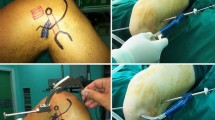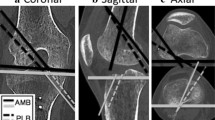Abstract
Purpose
The all-inside tibial tunnel preparation technique of arthroscopic anterior cruciate ligament (ACL) reconstruction differs from traditional complete tibial tunnel technique in using closed tibial sockets, dual-cortical suspensory graft-fixation, quadrupled semitendinosus tendon graft and lesser bone removal. The study aims to find out if all-inside technique differs from complete tibial tunnel technique of single bundle ACL reconstruction in terms of graft dimensions, functional and clinical outcomes.
Methods
A prospective comparative study was conducted including 80 patients with isolated ACL tears, divided into 2 groups of 40 patients each without any randomization. The two techniques differed in tibial tunnel preparation. Group 1 underwent ACL reconstruction with a complete tibial tunnel drilled from the anteromedial tibial cortex and group 2 underwent all-inside tibial socket preparation. Duration of the surgery, perioperative and midterm complications were noted. All patients had 24 month follow-up. Functional outcome scores (Tegner-Lysholm knee scoring scale and IKDC score) were assessed preoperatively and postoperatively at 6 months and 24 months. Hamstring and quadriceps muscle strength was assessed preoperatively and postoperatively at 6 months, 9 months and 24 months. Visual analogue score (VAS) for knee pain was assessed preoperatively and postoperatively at day 2, 2 weeks, 6 weeks, 6 months and 24 months.
Results
Quadrupled semitendinosus tendon graft was significantly thicker than doubled semitendinosus and gracilis tendons graft (8.17 ± 0.58 vs 8.71 ± 0.4, p < 0.0001). The VAS score for knee pain at 2 and 6 weeks were lower in group 2 (5.75 ± 0.6 and 1.78 ± 1.0) as compared to group 1 (6.50 ± 0.5 and 2.5 ± 0.8) and the difference was statistically significant (P = 0.0007 and p = 0.002 respectively). There were no statistically significant differences in functional outcome scores and quadriceps muscle strength between the two groups. However, there were significant difference in hamstring power in two groups.
Conclusion
The all-inside technique has the advantages of using a single tendon graft, lesser early postoperative pain with similar clinical and functional outcomes compared to the complete tibial tunnel technique.
Level of Evidence IIProspective comparative study



Similar content being viewed by others
Availability of data and material
The datasets used and/or analysed during the current study are available from the corresponding author on reasonable request.
References
Lubowitz JH, Amhad CH, Anderson K (2011) All-inside anterior cruciate ligament graft-link technique: Second-generation, no-incision anterior cruciate ligament reconstruction. Arthrosc - J Arthrosc Relat Surg 27:717–727. https://doi.org/10.1016/j.arthro.2011.02.008
Wilson AJ, Yasen SK, Nancoo T, Stannard R, Smith JO, Logan JS (2013) Anatomic all-inside anterior cruciate ligament reconstruction using the translateral technique. Arthrosc Tech. https://doi.org/10.1016/j.eats.2012.12.002
Lubowitz JH (2006) No-Tunnel Anterior Cruciate Ligament Reconstruction: The Transtibial All-Inside Technique. Arthrosc - J Arthrosc Relat Surg 22:900.e1-900.e11. https://doi.org/10.1016/j.arthro.2006.06.003
Benea H, d’Astorg H, Klouche S, Bauer T, Tomoaia G, Hardy P (2014) Pain evaluation after all-inside anterior cruciate ligament reconstruction and short term functional results of a prospective randomized study. Knee 21:102–106. https://doi.org/10.1016/j.knee.2013.09.006
Lubowitz JH, Schwartzberg R, Smith P (2013) Randomized controlled trial comparing all-inside anterior cruciate ligament reconstruction technique with anterior cruciate ligament reconstruction with a full tibial tunnel. Arthrosc - J Arthrosc Relat Surg 29:1195–1200. https://doi.org/10.1016/j.arthro.2013.04.009
Volpi P, Bait C, Cervellin M, Denti M, Prospero E, Morenghi E, Quaglia A (2014) No difference at two years between all inside transtibial technique and traditional transtibial technique in anterior cruciate ligament reconstruction. Muscles Ligaments Tendons J 4:95–99
Monaco E, Fabbri M, Redler A, Gaj E, De Carli A, Argento G, Saithna A, Ferretti A (2019) Anterior cruciate ligament reconstruction is associated with greater tibial tunnel widening when using a bioabsorbable screw compared to an all-inside technique with suspensory fixation. Knee Surgery, Sport Traumatol Arthrosc 27:2577–2584. https://doi.org/10.1007/s00167-018-5275-x
Mayr R, Smekal V, Koidl C, Coppola C, Eichinger M, Rudisch A, Kranewitter C, Attal R (2020) ACL reconstruction with adjustable-length loop cortical button fixation results in less tibial tunnel widening compared with interference screw fixation. Knee Surgery, Sport Traumatol Arthrosc 28:1036–1044. https://doi.org/10.1007/s00167-019-05642-9
Kouloumentas P, Kavroudakis E, Charalampidis E, Kavroudakis D, Triantafyllopoulos GK (2019) Superior knee flexor strength at 2 years with all-inside short-graft anterior cruciate ligament reconstruction vs a conventional hamstring technique. Knee Surgery, Sport Traumatol Arthrosc 27:3592–3598. https://doi.org/10.1007/s00167-019-05456-9
Kaplan Y, Witvrouw E (2019) When Is It Safe to Return to Sport After ACL Reconstruction? Reviewing the Criteria. Sports Health 11:301–305
Mariscalco MW, Flanigan DC, Mitchell J, Pedroza AD, Jones MH, Andrish JT, Parker RD, Kaeding CC, Magnussen RA (2013) The influence of hamstring autograft size on patient-reported outcomes and risk of revision after anterior cruciate ligament reconstruction: A multicenter orthopaedic outcomes network (MOON) cohort study. Arthrosc - J Arthrosc Relat Surg 29:1948–1953. https://doi.org/10.1016/j.arthro.2013.08.025
Conte EJ, Hyatt AE, Gatt CJ, Dhawan A (2014) Hamstring autograft size can be predicted and is a potential risk factor for anterior cruciate ligament reconstruction failure. Arthrosc - J Arthrosc Relat Surg 30:882–890
Spragg L, Chen J, Mirzayan R, Love R, Maletis G (2016) The effect of autologous hamstring graft diameter on the likelihood for revision of anterior cruciate ligament reconstruction. Am J Sports Med 44:1475–1481. https://doi.org/10.1177/0363546516634011
Goyal T, Paul S, Das L, Choudhury AK (2020) Correlation between anthropometric measurements and activity level on length and diameter of semitendinosus tendon autograft in knee ligament surgery: A prospective observational study. SICOT-J. https://doi.org/10.1051/sicotj/2020007
Duerr RA, Garvey KD, Ackermann J, Matzkin EG (2019) Influence of graft diameter on patient reported outcomes after hamstring autograft anterior cruciate ligament reconstruction. Orthop Rev (Pavia) 11:129–133. https://doi.org/10.4081/or.2019.8178
Shantanu K, Kushwaha SS, Kumar D, Kumar V, Singh S, Sharma V (2016) A comparative study of the results of the anatomic medial portal and all inside arthroscopic ACL reconstruction. J Clin Diagnostic Res. 10(11):RC0–RC03. https://doi.org/10.7860/JCDR/2016/23696.8812
Patrick NC, Kowalski CA, Hennrikus WL (2017) Surgical efficiency of anterior cruciate ligament reconstruction in outpatient surgical center versus hospital operating room. Orthopedics 40:297–302. https://doi.org/10.3928/01477447-20170621-01
Crawford DC, Li CS, Sprague S, Bhandari M (2015) Clinical and cost implications of inpatient versus outpatient orthopedic surgeries: A systematic review of the published literature. Orthop Rev (Pavia) 7:116–121
Yosmaoglu HB, Baltaci G, Ozer H, Atay A (2011) Effects of additional gracilis tendon harvest on muscle torque, motor coordination and knee laxity in ACL reconstruction. Knee Surgery, Sport Traumatol Arthrosc 19:1287–1292. https://doi.org/10.1007/s00167-011-1412-5
Yamazaki S, Yasuda K, Tomita F, Minami A, Tohyama H (2006) The effect of intraosseous graft length on tendon-bone healing in anterior cruciate ligament reconstruction using flexor tendon. Knee Surgery, Sport Traumatol Arthrosc 14:1086–1093. https://doi.org/10.1007/s00167-006-0110-1
Zantop T, Ferretti M, Bell KM (2008) Effect of tunnel-graft length on the biomechanics of anterior cruciate ligament-reconstructed knees: Intra-articular study in a goat model. Am J Sports Med 36:2158–2166. https://doi.org/10.1177/0363546508320572
Bostman O, Hirvensalo E, Makinen J, Rokkanen P (1990) Foreign-body reactions to fracture fixation implants of biodegradable synthetic polymers. J Bone Jt Surg - Ser B 72:592–596. https://doi.org/10.1302/0301-620x.72b4.2199452
Fridén T, Rydholm U (1992) Severe aseptic synovitis of the knee after biodegradable internal fixation: A case report. Acta Orthop 63:94–97. https://doi.org/10.3109/17453679209154859
Magen HE, Howell SM, Hull ML (1999) Structural properties of six tibial fixation methods for anterior cruciate ligament soft tissue grafts. Am J Sports Med 27:35–43. https://doi.org/10.1177/03635465990270011401
Johnson JS, Smith SD, Laprade CM, Turnbull TL, Laprade RF, Wijdicks CA (2015) A biomechanical comparison of femoral cortical suspension devices for soft tissue anterior cruciate ligament reconstruction under high loads. Am J Sports Med 43:154–160. https://doi.org/10.1177/0363546514553779
Browning WM, Kluczynski MA, Curatolo C, Marzo JM (2017) Suspensory Versus Aperture Fixation of a Quadrupled Hamstring Tendon Autograft in Anterior Cruciate Ligament Reconstruction: A Meta-analysis. Am J Sports Med 45:2418–2427. https://doi.org/10.1177/0363546516680995
Onggo JR, Nambiar M, Pai V (2019) Fixed- Versus Adjustable-Loop Devices for Femoral Fixation in Anterior Cruciate Ligament Reconstruction: A Systematic Review. Arthrosc - J Arthrosc Relat Surg 35:2484–2498
Singh S, Ramos-Pascual S, Czerbak K, Malik M, Schranz PJ, Miles AW, Mandalia V (2020) Biomechanical testing of fixed and adjustable femoral cortical suspension devices for ACL reconstruction under high loads and extended cyclic loading. J Exp Orthop. https://doi.org/10.1186/s40634-020-00235-9
Fu CW, Chen WC, Lu YC (2020) Is all-inside with suspensory cortical button fixation a superior technique for anterior cruciate ligament reconstruction surgery? A systematic review and meta-analysis. BMC Musculoskelet Disord. https://doi.org/10.1186/s12891-020-03471-3
Pautasso A, Capella M, Barberis L, Drocco L, Giai Via R, Bistolfi A, Massè A, Sabatini L (2020) All-inside technique in ACL reconstruction: mid-term clinical outcomes and comparison with AM technique (Hamstrings and BpTB grafts). Eur J Orthop Surg Traumatol. https://doi.org/10.1007/s00590-020-02798-w
Mayr R, Smekal V, Koidl C, Coppola C, Fritz J, Rudisch A, Kranewitter C, Attal R (2017) Tunnel widening after ACL reconstruction with aperture screw fixation or all-inside reconstruction with suspensory cortical button fixation: Volumetric measurements on CT and MRI scans. Knee 24:1047–1054. https://doi.org/10.1016/j.knee.2017.06.007
Petre BM, Smith SD, Jansson KS, De Meijer PP, Hackett TR, Laprade RF, Wijdicks CA (2013) Femoral cortical suspension devices for soft tissue anterior cruciate ligament reconstruction: A comparative biomechanical study. Am J Sports Med 41:416–422. https://doi.org/10.1177/0363546512469875
Monaco E, Redler A, Fabbri M, Proietti L, Gaj E, Daggett M, Ferretti A (2019) Isokinetic flexion strength recovery after ACL reconstruction: a comparison between all inside graft-link technique and full tibial tunnel technique. Phys Sportsmed 47:132–135. https://doi.org/10.1080/00913847.2018.1537535
Funding
There is no funding source.
Author information
Authors and Affiliations
Contributions
Dr Tarun Goyal: Planning of study, patient enrolment, writing of manuscript. Dr Lakshmana Das: Data management, manuscript preparation. Dr Souvik Paul: Evaluation of functional outcomes, patient enrolment, writing of manuscript, manuscript preparation. Dr Arghya Kundu Choudhury: Patient enrolment, Data collection. Dr. Siddharth S Sethy: Patient enrolment, Data collection.
Corresponding author
Ethics declarations
Conflict of interest
The author(s) declared no potential conflicts of interest with respect to the research, authorship and/or publication ofthis article.
Ethical approval
The institutional ethics committee approved the study (AIIMS/IEC/18/141).
Informed consent
Informed consent was obtained from all individual participants included in the study.
Consent for publication
The author(s) give consent for publication of this article.
Additional information
Publisher's Note
Springer Nature remains neutral with regard to jurisdictional claims in published maps and institutional affiliations.
Rights and permissions
About this article
Cite this article
Goyal, T., Das, L., Paul, S. et al. Outcomes of retro-drilled all-inside tibial tunnel vs complete tibial tunnel techniques in anterior cruciate ligament reconstruction—a comparative study. Eur J Orthop Surg Traumatol 32, 523–532 (2022). https://doi.org/10.1007/s00590-021-03011-2
Received:
Accepted:
Published:
Issue Date:
DOI: https://doi.org/10.1007/s00590-021-03011-2




